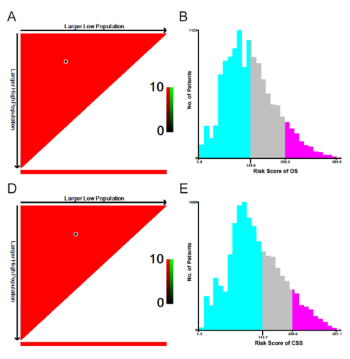Construction of the prognostic nomogram and treatment recommendation in patients with mixed endometrial carcinoma treated with hysterectomy
DOI:
https://doi.org/10.17305/bb.2024.10754Keywords:
Mixed endometrial carcinomas, SEER, nomogram, prognosis, treatmentAbstract
Mixed endometrial carcinomas (MECs) account for approximately 3%–10% of all endometrial carcinomas (ECs). These are defined as a combination of two or more distinct histologic subtypes, with at least one being a type II tumor that constitutes at least 5% of the overall tumor. However, the associated prognostic factors and treatment of MECs remain unclear. The study aimed to identify the
independent prognostic factors of MEC patients treated with hysterectomy and to explore the optimal treatment modalities for overall survival (OS) and cancer-specific survival (CSS). Using the Surveillance, Epidemiology, and End Results (SEER) database, a total of 12,848 MEC patients treated with hysterectomy were screened. Independent prognostic factors were identified by Cox regression analysis and used to construct the nomogram. The concordance indices (C-indices) of OS and CSS were 0.807 and 0.834 in the training set. Validation of the nomogram revealed that the receiver operating curve (ROC) maintained good discrimination, the decision curve analysis (DCA) had a high net benefit rate, and the calibration curves showed high consistency. Patients were grouped by the nomogram formula and the number of positive regional lymph nodes (NPR-Lymph node) to evaluate the therapeutic outcomes of chemotherapy, radiotherapy, neoadjuvant treatment, and lymph node operation. Survival analysis revealed that chemotherapy could improve the prognosis for OS and CSS in the high-risk group and in the group with NPR-Lymph node counts above 1 (P < 0.05). Radiotherapy was associated with better OS and CSS in the intermediate-risk and high-risk groups, and in the group with NPR-Lymph node counts above 0 (P < 0.05). Lymphadenectomy was found to prolong OS and CSS in the high-risk group (P < 0.05), while neoadjuvant treatment did not prolong OS and CSS in any group. Thus, in this study, the nomogram for MEC patients treated with hysterectomy was successfully built and validated which could effectively predict the prognosis and identify at-risk population to guide clinical decision making. The NPR-Lymph node was identified as a potentially strong prognostic indicator with good clinical value.
Citations
Downloads

Downloads
Additional Files
Published
Data Availability Statement
Publicly available datasets were analyzed in this study. These data can be found in SEER Data & Software (cancer.gov).
Issue
Section
Categories
License
Copyright (c) 2024 Luyao Kang, Gaili Ji, Nan Zhang, Jie Meng, Duan Liu, Hongyu Li

This work is licensed under a Creative Commons Attribution 4.0 International License.









